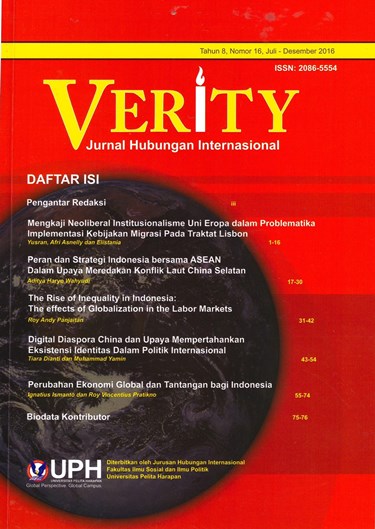Digital Diaspora China dan Upaya Mempertahankan Eksistensi Identitas Dalam Politik Internasional [The Digital Diaspora of China and Attempts to Maintain the Existence of Identity in International Politics]
DOI:
https://doi.org/10.19166/verity.v8i16.725Λέξεις-κλειδιά:
China Digital Diaspora, Community Development, Political Movement, Beijing StrategyΠερίληψη
Discussions on digital diaspora are relatively new in international relations studies. The birth of digital diaspora was driven by globalization and the increasing use of information and communications technology. The importance of digital diaspora recently has been recognized by some countries; this paper will discuss the digital diaspora of China. The emergence of digital diaspora was started by the Beijing Strategy in the Deng Xiaoping era. It has developed since the third generation of Chinese diaspora are better educated and skilled, so it is not surprising that it is easier for them to access the virtual world.
Chinese Digital diaspora can be seen as a great opportunity for the country with the capacity to make use of it and include it as part of the country’s public diplomacy. The possible role of digital diaspora can be manifested through their actions in community development and political movement committed in cyberspace. Chinese Digital diaspora action is based on their strong sense of belonging to the country of origin (homeland) and a sense of nationalism.
Αναφορές
Brinkerhoff, Jennifer M. 2009. Digital Diasporas Identity and Transnational Engagement. Cambridge, England: Cambridge University Press. https://doi.org/10.1017/CBO9780511805158
Choucri, Nazli. 2012. Cyberpolitics in International Relations. The MIT Press: Cambridge, MA.
Crouch, Gilles. 2011. Digital Diaspora In Canada: Understanding Their Role and Influence. The Philanthropist, 24(1), 63-64. https://thephilanthropist.ca/original-pdfs/Philanthropist-24-1-467.pdf
Ding, Sheng. 2007. Digital Diaspora and National Image Building: A New Perspective on Chinese Diaspora Study in the Age of China’s Rise. Pacific Affairs. Vancouver, BC: University of British Columbia.
Ding, Sheng. July 2010. Sons of The Yellow Emperor Go Online: The State of the Chinese Digital Diaspora. Global Migration and Transnational Politics Working Paper no.13
Dufoix, Stephane. 2008. Diasporas. Oakland, CA: University of California Press. https://doi.org/10.1525/california/9780520253599.001.0001
Santoso, M. June 2014. Diaspora Globalisme, Keamanan, dan Keimigrasian. Bandung, Indonesia: Pustaka Reka Cipta.
Tan, Leon. Diasporas in a digital age. Ephemera Reviews: Theory & Politics in Organization, 11(3), 325-328.
Unutulmaz, Onur. July 2012. Digital Diaspora: Definition, Evaluation and Policy Recommendations. YeniDiplomasi.com.
Wibowo, I. January 2004. Belajar dari Cina: bagaimana Cina merebut peluang dalam era globalisasi. Jakarta, Indonesia: PT Kompas Media Nusantara.
Zhang, Juan & Nyiri, Pal. 2014. ”˜Wall’ activism: transnational social movements and the politics of Chinese cyber-public space. International Development Planning Review, 36(1), 111-131. https://doi.org/10.3828/idpr.2014.7
Zhu, Zhiqun. 2011. The People’s Republic of China Today: Internal and External Challenges. Lewisburg, PA: Bucknell University.
Λήψεις
Δημοσιευμένα
Τεύχος
Ενότητα
Άδεια
Authors who publish with this journal agree to the following terms:
1) Authors retain copyright and grant the journal right of first publication with the work simultaneously licensed under a Creative Commons Attribution License (CC-BY-SA 4.0) that allows others to share the work with an acknowledgement of the work's authorship and initial publication in this journal.
2) Authors are able to enter into separate, additional contractual arrangements for the non-exclusive distribution of the journal's published version of the work (e.g., post it to an institutional repository or publish it in a book), with an acknowledgement of its initial publication in this journal.
3) Authors are permitted and encouraged to post their work online (e.g., in institutional repositories or on their website). The final published PDF should be used and bibliographic details that credit the publication in this journal should be included.


